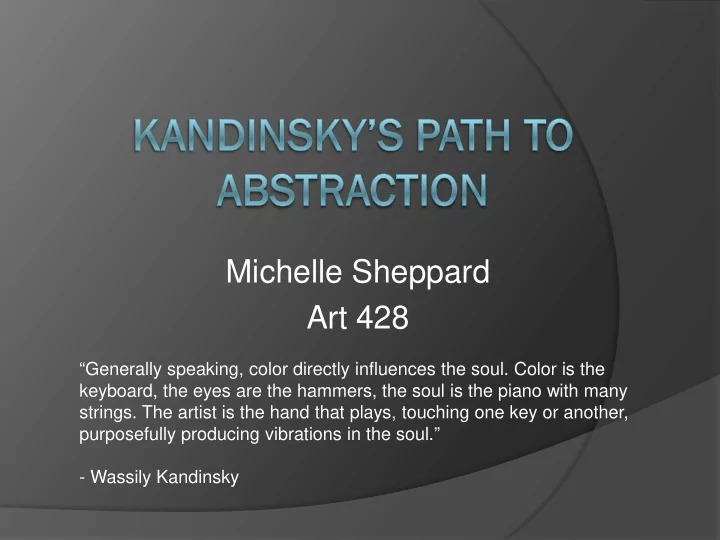

Michelle Sheppard Art 428 “Generally speaking, color directly influences the soul. Color is the keyboard, the eyes are the hammers, the soul is the piano with many strings. The artist is the hand that plays, touching one key or another, purposefully producing vibrations in the soul.” - Wassily Kandinsky
This painting by Kandinsky relates to the above quote because he uses bright colors to stir an “inner vibration” of the soul. This piece represents the idea of combined Russian beliefs in Christianity and paganism, but uses nonrepresentational colors to evoke dormant spirits within the viewer along with symbolic cues. This painting is an example of Kandinsky’s belief that art should be a “child of its time.” Through his travels he “Motley Life” 1907 developed a sense of being implemented into the great painting of life, to “live” in the picture.
“Houses in Murnau” is an example of the influence of fauvism on Kandinsky’s work. Bright colors become fundamentally significant in his paintings and he migrates away from post- impressionist landscapes. Although color is a significant aspect of Kandinsky’s art, it is not the key to him as an artist. His goal was simply to “paint good, necessary, living pictures, which are experienced properly by at least a few viewers” (Art in “Houses in Murnau” 1908 Theory, pg. 93).
“Improvisation XIV” 1910 Kandinsky moves into abstraction through various Impressions, Improvisations, and Compositions which can sometimes be interchangeable. His Improvisations are inspired by spiritual events and impulses. His work becomes less about truly representing landscapes and more about vague forms and color experimentation.
This “Sea Battle” painting by Kandinsky is another example of a combination of his beliefs about art. The dark strokes and lines form symbolic and ambiguous ships amongst chaos in the sea. Each color represents a different vibration of sound from natural elements such as fire and water. The audience is left with the energy of the battle scene. Kandinsky uses all of these elements to touch the viewer’s soul by engaging them in the painting. “Improvisation 31 (Sea Battle)” 1913
Kandinsky was heavily influenced and inspired my music and believed it was the ultimate form of artistic abstraction. The music of the concert conjured emotional impulses in which he expressed through colors, which is his internal “impression” of an external nature. He believed these bright colors had a psychological power and exerted a direct influence upon the soul, in which he developed the “Impression III (Concert) 1911 principle of internal necessity (Art in Theory, pg. 89).
During and after the Bauhaus, Kandinsky’s work becomes dramatically different. Although it can seem misleading from his larger set of beliefs about art because of the newly implemented use of linear and geometric motifs, it is the embodiment of his new interest in the fourth dimension and still conceptually engages the viewer into his total work of art. Here in “Composition VIII,” he has carefully drafted and planned the use of his space “Composition VIII” 1923 and retracted from the prominent bright colors.
Although these paintings suggest infinite space rather than material representations of the world, and are so different from his prior works, Kandinsky continues to paint to commit to his inner necessity. He continues to stay true to himself as an artist, paint through his impulse to “purposefully create”, and captures the spirit and new developments and ideas within his age (the pyramid of inner necessity, The Spaces of “Composition IX” 1936 Spirituality and Absolute Abstraction: Kandinsky).
Recommend
More recommend